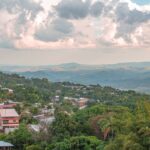Multi-stakeholder partnerships and the need for collaborative action in the face of an rapidly changing climate were front and center during last month’s United Nations Framework Convention on Climate Change (UNFCCC) COP 27. 1000L partners Rainforest Alliance and Landscape Finance Lab joined forces with World Vision Australia and the Ikea Foundation during week two for the side event, A Spotlight on Natural Climate Solutions: Scaling Land Restoration to Benefit People and Nature. The event, which featured powerhouse speakers Paul Chatterton, Tony Rinaudo, Nico Janessen, Nadege Nzoyem and Tirhas Mebrahtu Hindeya, offered audiences a deep dive into the power of locally-led, multi-stakeholder solutions in building climate resilience at a landscape scale.
World Vision’s Tony Rinaudo opened with the inspiring story of how the Farmer Managed Natural Regeneration (FMNR) approach transformed the previously degraded landscapes of Niger. After failing to scale tree-planting programs, he refocused efforts on equipping local farmers with knowledge and resources to access dormant seeds and adopt agroforestry practices within their landscape. Within a few years, a farmer-to-farmer training network had spread across Niger, resulting in the restoration of over 5 million hectares of farm land. The key to success, he noted, was mobilizing farmers in building natural solutions that served to benefit both the land and their livelihoods. This ultimately led to what Rinaudo described as “a movement that spontaneously catalyzed the spread” of FMNR across the region.
These locally-led movements can be a powerful driver of landscape-level change – but they need access to the right tools, environment and resources. The session continued by spotlighting two additional case studies from Ethiopia and Cameroon that had a strong common element: carefully designed, well-managed, multi-stakeholder collaboration. Ethiopian government representative Tirhas Mebrahtu Hindeya noted the series of obstacles that the region initially faced. “Insecure land and tree tenure, lack of knowledge on best management practices, poor links to markets, a shortage of quality seedlings, a lack of basic knowledge on multi-stakeholder platforms and limited financial resources were significant challenges within our landscapes,” she noted, citing a clear need for systems-wide transformation.
With support from World Vision’s ReGreening the Globe initiative, the country formed a national alliance that included partners from the national, subnational and community level. They developed a framework and action plan that included representatives from multiple sectors, and designed a platform that allowed them to exchange knowledge, access data and plan for the future. To date, the 93,000 households that have employed FMNR within Ethiopia have seen increases in income, food security and crop health.
Rainforest Alliance’s Nadege Nzoyem reinforced the importance of national and subnational government involvement as she shared the story of building multi-stakeholder partnerships in Cameroon. “The answer to making our landscape strategy was to implement a multi-stakeholder approach to land governance,” Nzoyem said. “We needed collaboration from everyone to help identify the problems and contribute to decisions.”
Underpinning each of these success stories is fundamental access to resources and the structures to maximize them. Landscape Finance Lab’s Paul Chatterton noted the power of using the landscape approach to package projects in a way that inspires real investment from financiers. Further, he noted that the landscape approach can help seemingly disparate sectors find common ground. “It allows people to speak with the same landscape language. If you put fishers in the same room as foresters, they generally don’t have much to talk about. But if they’re talking about land- and seascapes, they’re speaking the same language.” It’s this language, he noted, that can be used to generate interest from investors in the long run.
The final key ingredient panelists identified in scaling locally-led restoration solutions was time. Speakers unanimously agreed that this process was not for the faint of heart, nor for those looking to see instant results. Nico Janessen joined the panel as a representative of the Ikea Foundation, a core funder of 1000 Landscapes for 1 Billion People, to emphasize the necessity for long-term financing for these types of initiatives. “Landscape approaches can be the holistic solution that solves the problems of today and combat those that may occur in the future,” he noted. “But you cannot accomplish a landscape approach by funding 2-3 year projects. You must take the time to nurture inclusivity and relationships. That’s how you find success.”


